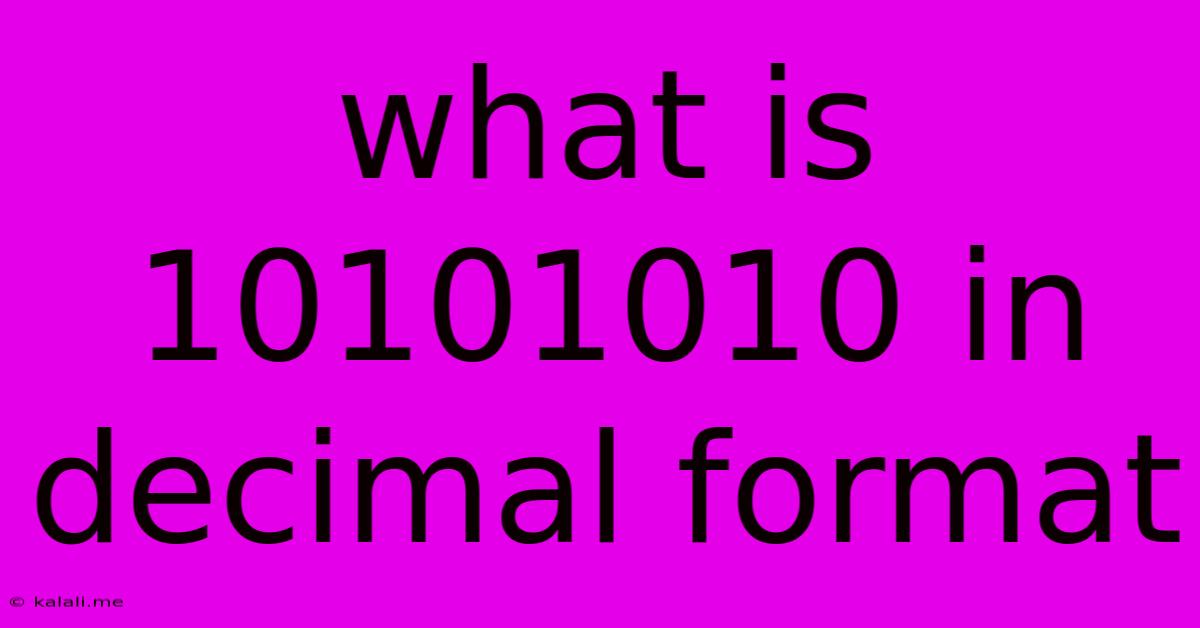What Is 10101010 In Decimal Format
Kalali
Jun 15, 2025 · 2 min read

Table of Contents
What is 10101010 in Decimal Format? A Beginner's Guide to Binary-Decimal Conversion
Have you ever encountered a sequence of 0s and 1s and wondered what it means? This string of digits, often seen in computing, represents a number in the binary system. This article will explain how to convert the binary number 10101010 into its decimal equivalent. Understanding this conversion is fundamental to comprehending how computers store and process information.
Understanding Binary and Decimal Systems
Before diving into the conversion, let's clarify the differences between the binary and decimal systems. The decimal system, which we use daily, is a base-10 system. This means it uses ten digits (0-9) and each position in a number represents a power of 10. For example, the number 123 represents (1 x 10²) + (2 x 10¹) + (3 x 10⁰).
The binary system, on the other hand, is a base-2 system. It uses only two digits: 0 and 1. Each position in a binary number represents a power of 2. This is why binary numbers are also called base-2 numbers.
Converting 10101010 from Binary to Decimal
To convert 10101010 from binary to decimal, we need to understand the positional values of each digit. Let's break it down:
| Digit | Positional Value (Power of 2) | Decimal Value |
|---|---|---|
| 1 | 2⁷ (128) | 128 |
| 0 | 2⁶ (64) | 0 |
| 1 | 2⁵ (32) | 32 |
| 0 | 2⁴ (16) | 0 |
| 1 | 2³ (8) | 8 |
| 0 | 2² (4) | 0 |
| 1 | 2¹ (2) | 2 |
| 0 | 2⁰ (1) | 0 |
Now, let's sum up the decimal values: 128 + 0 + 32 + 0 + 8 + 0 + 2 + 0 = 170
Therefore, 10101010 in binary is equal to 170 in decimal.
Practical Applications of Binary-Decimal Conversion
Understanding binary-decimal conversion is crucial for various applications, including:
- Computer programming: Programmers frequently need to convert between binary and decimal representations of numbers.
- Digital electronics: Binary numbers are fundamental to how digital circuits work.
- Networking: IP addresses and network masks are often represented in binary form.
- Data storage: Data is stored in computers using binary code.
Conclusion
Converting binary numbers to decimal might seem complex at first, but with a clear understanding of the positional values in the binary system, it becomes a straightforward process. This conversion is a foundational concept in computer science and related fields. By mastering this conversion, you'll gain a deeper understanding of how computers function at their most basic level. Remember the simple steps outlined above, and you'll be well on your way to confidently converting binary numbers to their decimal equivalents.
Latest Posts
Latest Posts
-
For A Given Wave If The Frequency Doubles The Wavelength
Jun 15, 2025
-
The Founding Playwright Of The Realist Era Was
Jun 15, 2025
-
Consider The Circuit Shown In The Figure
Jun 15, 2025
-
Which Of The Following Are Characteristics Of Service Provider Operations
Jun 15, 2025
-
Which One Of The Following Is An Intensive Property
Jun 15, 2025
Related Post
Thank you for visiting our website which covers about What Is 10101010 In Decimal Format . We hope the information provided has been useful to you. Feel free to contact us if you have any questions or need further assistance. See you next time and don't miss to bookmark.